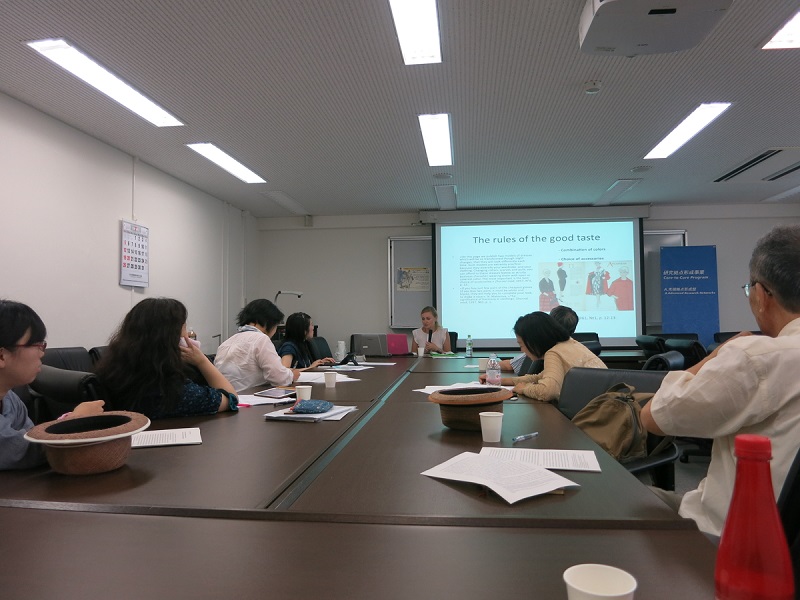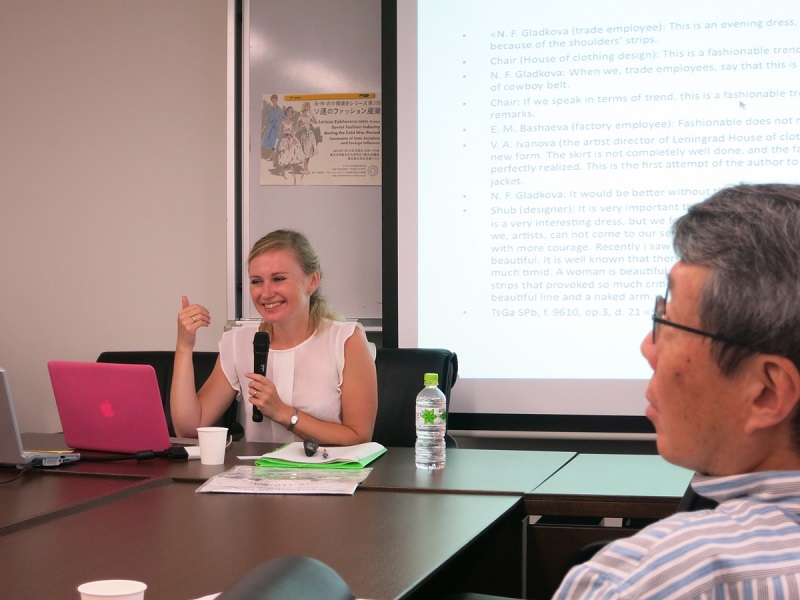2015.08.13
2015年度第2回GHCセミナー(7月13日)The 2nd GHC Seminar 2015(Jul.13)
2015年7月13日午後,パリ・社会科学高等研究院のラリッサ・ザハロワ准教授をお迎えし,糸・布・衣の循環史研究会第3回ワークショップ共催の形で,第2回GHCセミナーが開催された。報告は以下の通りである。
Larissa Zakharova (EHESS, France)
"Soviet Fashion Industry during the Cold War Period: Constraints of State Socialism and Foreign Influence"
報告ではまず,政治体制との合致が求められるソ連のファッションのあり方について概観された。ファッションは本質的に社会主義的な計画経済や階級なき社会とは矛盾するものであり,ソ連では「西側」的,「ブルジョワ」的ファッションとは異なるものが目指された。デザイナーらはTPOに合わせるなどの「良き趣味」を民衆に伝える公僕であり,国内で発行されるファッション雑誌は「良き趣味」の教育メディアだった。また実際に製造される衣服について言えば,1960年代初頭でも衣服工場では古いパターンが多く用いられており,「アパレル産業」は存在しても「ファッション産業」は存在しない状況だった。
変化が始まるのは1950年代末からである。政府はソ連のアパレル産業の問題点を鑑み,資本主義国との接触から新しい可能性を模索し,西側諸国からの機械・機具及び消費財の輸入,国家主導の工業博覧会,デザイナーの海外派遣などが試みられる。たとえば,1959年にはディオールがモスクワでコレクションを開催し,イヴ・サン゠ローランのデザイン要素をサラファンなどの伝統的衣装に取り入れるといったデザイン上の試みも行われた。こうした衣とファッションを巡る流れはソ連の消費文化そのものの変貌と軌を一にするものだった。輸入映画,ファッション雑誌,西側諸国からソ連への観光,ソ連から西側諸国への観光や公的派遣,密輸などにより西側諸国との接触は増す。プライヴェート・セクターにおける市場メカニズム形成により,計画経済の問題点を補うことが目指され,法的措置も執られた。プライヴェート・セクターでの競争は国家の衣服製造におけるサーヴィス向上に結びつくことになる。
つまり,「鉄のカーテン」が開き始めたこの時期には,社会主義,計画経済,「良き趣味」といったソ連の従来的なあり方に対し,資本主義,需要と消費の製造への影響力,ファッションといった「西側」要素をコントロールしつつ取り入れ,ソ連内の問題を改革することが目されていた。しかし,様々な形で入り込む「西側」要素はソ連の日常生活と消費文化を変え,改革を失敗させることになる。
以上の報告の後,質問とコメントの時間が持たれた。当時ソ連が認識していた「西側」諸国の範疇,ソ連でのファッション・クリエイションのシステムなど,様々な角度からの論点が見出された。
「東側」が「西側」に接触を深めた時期にその狭間でなにが起きたかを,衣という具体的なモノやファッションという人々の美的感覚や生活感覚を左右する要素を通して論じ,非常に有意義なセミナーとなったと言えよう。
(文責:角田奈歩)
On the afternoon of July 13, 2015, the 2nd GHC Seminar was held in conjunction with the 3rd Workshop of Linking Cloth-Clothing Globally (LCCG), featuring Assoc. Prof. Larissa Zakharova of the École des Hautes Études en Sciences Sociales (EHESS) in Paris as the invited speaker.
Larissa Zakharova (EHESS, France)
“Soviet Fashion Industry during the Cold War Period: Constraints of State Socialism and Foreign Influence”
Zakharova began by outlining the nature of fashion in the USSR constrained by the political system. Given that fashion fundamentally contradicted the concept of a socialist planned economy and classless society, the Soviet Union pursued a type of fashion that differed from so-called “Western” or “Bourgeois” fashion. Designers were public servants whose task was to impart “good taste” that took into consideration TPO (Time, Place, Occasion) to the masses, and domestic fashion magazines were educational media to this end. In terms of the clothing that was actually produced, clothing factories still used old patterns even in the early 1960s. So, although there was an apparel industry, there was no fashion industry.
This began to change at the end of the 1950s. The government was aware of the problems of the domestic apparel industry, and hoping to find new possibilities through contact with capitalist countries, began importing machinery, tools, and consumable goods from Western countries, hosting state-sponsored industrial fairs, and dispatching designers overseas. For example, a fashion show of Christian Dior couture was held in Moscow in 1959, and an effort was made to incorporate design elements from Yves Saint Laurent into sarafan (Russian folk dress) and other traditional clothing. The evolution of clothing and fashion during this period paralleled the transformation of Soviet consumer culture. Contact with the West was increasing through the import of movies, fashion magazines, visits to the Soviet Union by Western tourists, visits to the West by Soviet tourists, the dispatch of Soviet officials to the West, and the smuggling of contraband goods. Various efforts, including legislative measures, were made to introduce private sector market mechanisms to compensate for the shortcomings of the planned economy. Competition in the private sector led to improvement in the service-orientation of State-run clothing manufacturing.
That is to say, during this period when the iron curtain was starting to lift, the Soviet Union began to incorporate Western elements such as capitalism, influence of demand and consumption on production, and fashion in a controlled manner as an alternative to the socialism, planned economy, and “good taste” of the Soviet Union up to that point with the aim of bringing about reforms that would resolve domestic problems. However, Western elements that penetrated in various ways ended up changing daily life and consumer culture in the Soviet Union but failed to bring about the desired reforms.
The presentation was followed by a Q&A session in which the presentation was discussed from various directions including the scope of “Western countries” as perceived by the then Soviet Union and the Soviet system for fashion creation.
The seminar explored the changes that occurred during a period in which the East sought contact with the West using the example of clothing (concrete objects) and fashion (elements influencing people’s aesthetic sense and lifestyles) and was extremely valuable.
(TSUNODA Nao)














